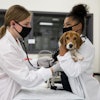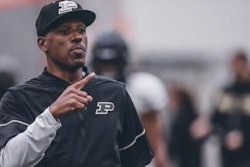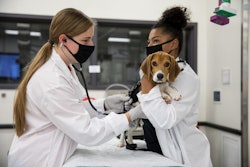On a recent Thursday evening, Samiatu Yussef sat thoughtfully at a table in an anatomy lab at the University Maryland, Baltimore (UMB). She says it’s one of her favorite subjects. On that day, she and her classmates are learning about the brain and drawing colorful posters. There is a lot of information to grasp. Having mentors nearby and a color-coded diagram helps, but a studious Yussef is busy jotting down words that are sure to help her master and recall each region of an organ and its function.
Madeline Nunez, her science teacher, says the anatomy lesson is a foundation before students actually see and feel what a real brain looks like. Yussef can’t wait for the reveal. For the eighth-grader who wants to be a neurosurgeon, hands-on learning opportunities like this are giving her a head start on a STEM career.
She’s just in middle school, but Yussef is already considered a young scientist. The spark for that dream was ignited when she entered the Continuing Umbrella of Research Experiences (CURE) program two years ago as a sixth-grader. At a ceremony similar to one experienced by first-year medical students, Yussef and her classmates received white lab coats to mark their induction into the prestigious STEM program that students attend at no cost. For them, the white coats may serve as a reminder that with access, opportunity and a clear path, they can become health care providers, scientists, clinicians and biomedical researchers — even in fields where few, today, look like them.
Since it launched in 2015 with funding from the National Cancer Institute (NCI), diversifying the city’s STEM talent pool while engaging students in cancer research and education has been the aim of UMB CURE. In 1999, NCI created CURE as a way to increase diversity in the cancer research workforce.
It targets high school students and undergraduates. But UMB decided that the entry point for its CURE program needed to be sooner, starting with the middle school years — a prime time to interest young students in STEM and engage them in enrichment programs, educators say. It recruits students and some of the program’s STEM teachers for CURE from three Baltimore public schools: Southwest Baltimore Charter School, Green Street Academy and Franklin Square Elementary and Middle School.
Josiah Bryant, 15, attends Green Street Academy. When he entered the program four years ago, Bryant was among the first class of students to give the UMB STEM initiative a try.
“CURE is giving us scholars an opportunity to better ourselves, our families and communities,” Bryant shared before finding a seat in the UMB CURE study hall to cram for a geometry test. Now in high school, Bryant has moved on to a new program called CURE Connections that’s working, so far, with ninth- and 10th-grade scholars to get them “college-ready,” says Dr. Gia Grier-McGinnis, executive director of UMB CURE. Plans are to add 11th- and 12th-graders too.















